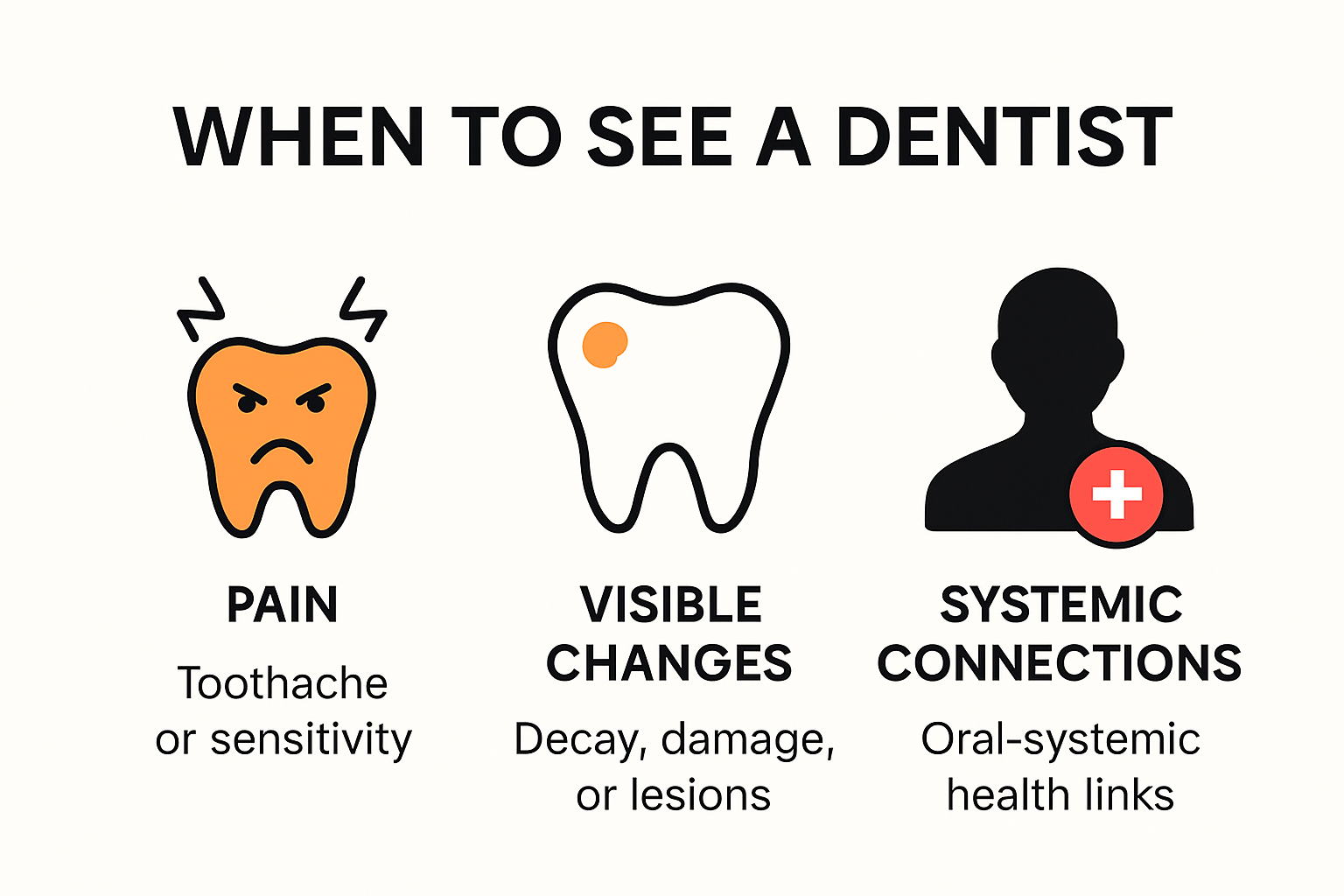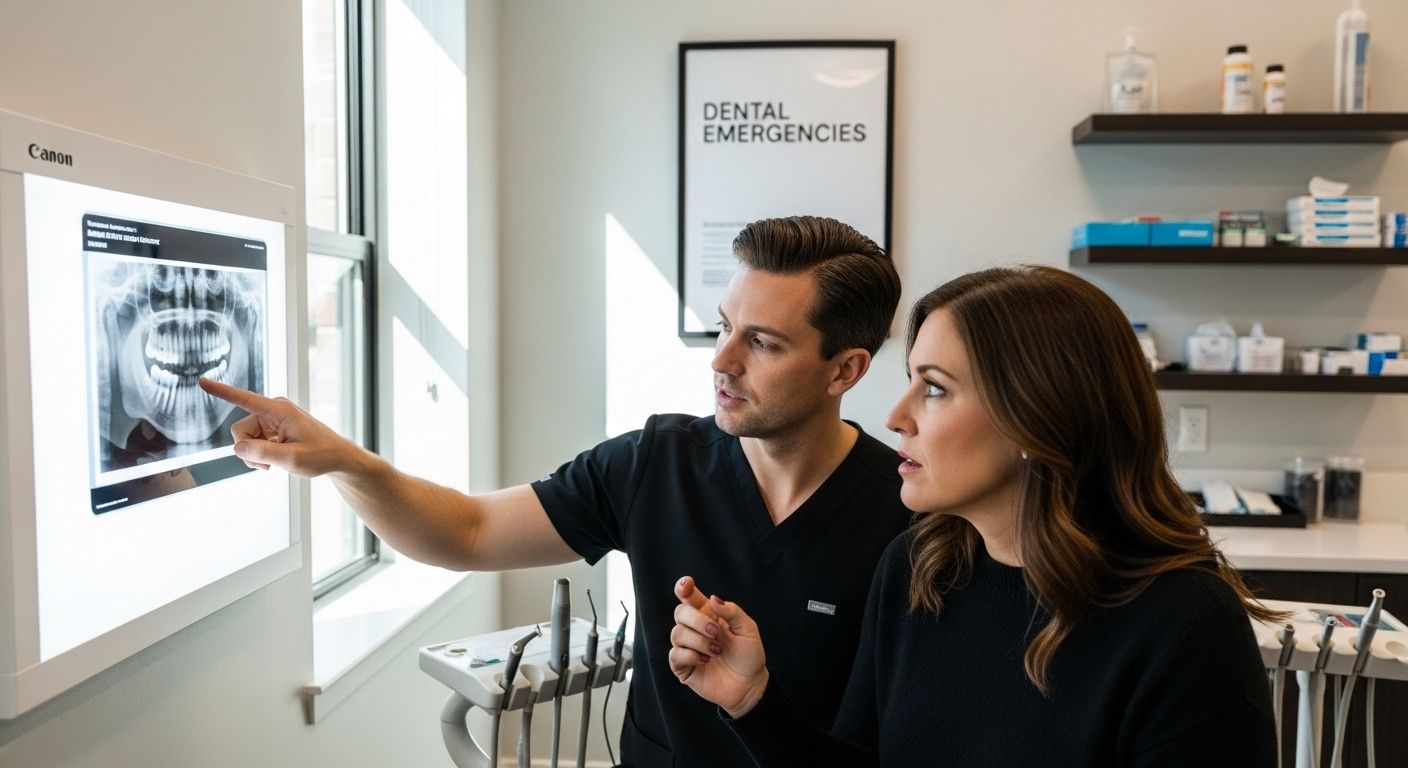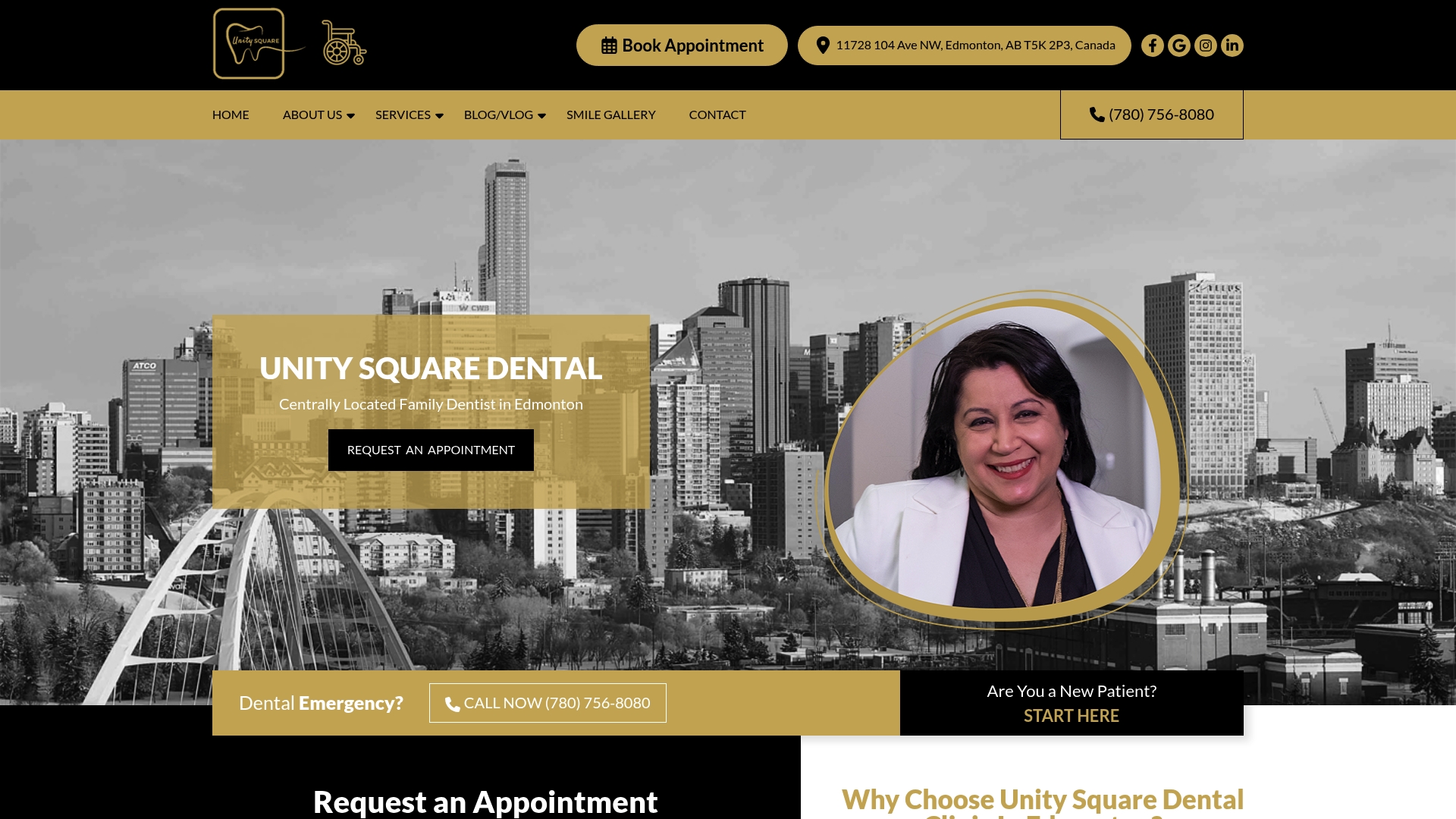
Tooth pain can bring even the bravest person to a halt and Canadians lose over 2.26 million workdays each year because of dental problems. You might think skipping an extra dentist trip saves money or time but that choice can actually lead to bigger health risks and unexpected costs down the road. Catching those warning signs early is not just about keeping your teeth white, it could be the difference between a simple fix and a full-blown emergency.
Table of Contents
- Common Signs You Should See a Dentist
- Special Considerations For Dental Anxiety And Accessibility
- Dental Emergencies And When To Act Fast
- Choosing The Right Dentist In Edmonton
Quick Summary
| Takeaway | Explanation |
|---|---|
| Recognize dental pain as a warning sign | Persistent dental pain indicates potential issues such as infections or cavities that require urgent care. |
| Look for visible changes in oral health | Signs like swollen gums or mouth sores suggest underlying problems needing professional evaluation. |
| Understand the impact of systemic health on dental care | Changes in health or medication can affect oral health, necessitating regular dental consultations. |
| Address dental anxiety with proactive strategies | Techniques such as pre-appointment discussions and sedation options can help ease patient fears. |
| Choose a dentist with verified credentials | Ensure your dentist is licensed, has advanced certifications, and boasts positive community reputation for trustworthy care. |
Common Signs You Should See a Dentist
Your oral health can reveal significant insights about your overall wellness. Recognizing when to see a dentist goes beyond routine checkups and requires understanding critical warning signs that demand professional attention. Learn more about preventive dental care to protect your long term health.
Persistent Pain and Discomfort
Dental pain is never normal and should never be ignored. Persistent toothaches, jaw pain, or sensitivity to hot and cold temperatures could signal serious underlying conditions. According to MedlinePlus, these symptoms might indicate infections, cavities, gum disease, or more complex dental issues requiring immediate professional evaluation.
Some specific pain indicators include:
- Sharp, continuous tooth pain that interrupts daily activities
- Throbbing sensations in your mouth or jaw
- Sensitivity when eating or drinking
- Unexplained headaches potentially linked to dental problems
Ignoring these signals can lead to more extensive and expensive treatments. Professional dentists can diagnose the root cause and provide targeted interventions before minor issues escalate.
Visible Changes in Oral Condition
Your mouth communicates its health through visible changes. Swollen gums, bleeding during brushing, white or red patches, mouth sores that don’t heal within two weeks, and unexplained lumps are critical signs requiring professional assessment.
Additional visual indicators include:
- Receding gum lines suggesting potential periodontal disease
- Discoloration or unusual spots on gums or teeth
- Loose teeth or significant changes in tooth alignment
- Chronic bad breath that persists despite good oral hygiene
These changes can represent early warning signs of more serious health conditions. A comprehensive dental examination can help identify and address potential risks before they become complicated medical issues.

Systemic Health Connections
Oral health is intricately connected with overall body wellness. Certain medical conditions and medications can manifest symptoms in your mouth. Diabetes, autoimmune disorders, and hormonal changes can significantly impact dental health.
Individuals experiencing the following should schedule a dental consultation:
- Recent diagnosis of chronic health conditions
- Changes in medication that might affect oral health
- Pregnancy or significant hormonal transitions
- Ongoing medical treatments like chemotherapy
Proactive dental care helps manage potential complications and supports your broader health management strategy. Regular professional assessments can detect early signs of systemic health challenges that might otherwise go unnoticed.
Special Considerations for Dental Anxiety and Accessibility
Dental experiences can be challenging for many individuals, particularly those with anxiety, physical disabilities, or past traumatic experiences. Understanding and addressing these unique needs is crucial for ensuring comprehensive and compassionate dental care. Explore our patient-centered approach to dental care to support patients with diverse requirements.
Understanding Dental Anxiety
Dental anxiety is a real and significant barrier that prevents many people from seeking necessary oral healthcare. According to research published in the National Center for Biotechnology Information, trauma-informed care approaches can substantially reduce patient fear and improve overall dental experience.
Common manifestations of dental anxiety include:
- Intense fear of dental procedures
- Panic attacks when scheduling or attending appointments
- Avoidance of dental visits for extended periods
- Physical symptoms like increased heart rate, sweating, and trembling
Professional dental practices recognize these challenges and implement specialized strategies to create a supportive, understanding environment. Techniques such as gentle communication, detailed explanations of procedures, and offering sedation options can help patients feel more comfortable and in control.
Accessibility and Inclusive Dental Care
Accessibility goes beyond physical accommodations. It encompasses creating an environment that welcomes and supports patients with diverse needs, including those with mobility challenges, sensory sensitivities, or communication differences.
Key accessibility considerations include:
- Wheelchair-friendly facilities with wide doorways and examination rooms
- Communication support for patients with hearing or speech impairments
- Flexible scheduling to accommodate various patient needs
- Sensory-friendly environments that minimize overwhelming stimuli
Practices committed to inclusive care understand that every patient deserves respectful, personalized treatment that acknowledges their unique circumstances and comfort levels.
Personalized Approaches to Overcoming Barriers
Addressing dental anxiety and accessibility requires a multifaceted, compassionate approach. Mental health intersects significantly with dental care, making it essential to develop strategies that prioritize patient emotional well-being.
Recommended strategies include:
- Pre-appointment consultations to discuss fears and develop comfort plans
- Gradual exposure techniques for patients with severe anxiety
- Collaborative decision-making that empowers patients
- Comprehensive patient education to demystify dental procedures
By creating a supportive, understanding environment, dental practices can help patients overcome barriers and receive the essential oral healthcare they need. The goal is not just treating teeth but nurturing overall patient wellness and confidence.
Dental Emergencies and When to Act Fast
Dental emergencies can strike unexpectedly, transforming a routine day into a critical health situation. Understanding the difference between urgent and non-urgent dental issues could save your tooth and prevent long-term complications. Discover the most critical dental emergency scenarios to be prepared when every minute counts.
Identifying True Dental Emergencies
Not all dental discomforts constitute an emergency, but some situations demand immediate professional intervention. According to the American Dental Association, certain conditions require urgent care to prevent permanent damage or serious health risks.
Critical signs that demand immediate dental attention include:
- Severe, uncontrolled bleeding from the mouth
- Significant facial swelling indicating potential infection
- Knocked-out or partially dislodged teeth
- Abscess with signs of spreading infection
- Intense, unbearable pain that interrupts daily functioning
These scenarios can quickly escalate from manageable issues to serious medical emergencies. Prompt action can mean the difference between saving and losing a tooth, or preventing a localized infection from becoming systemic.
To help readers recognize when a dental issue is an emergency, here’s a summary table of true dental emergency signs and the immediate recommended response mentioned in the article:
| Emergency Sign | Immediate Response |
|---|---|
| Severe, uncontrolled bleeding | Apply direct pressure with clean gauze |
| Significant facial swelling | Apply cold compress; contact dentist immediately |
| Knocked-out or partially dislodged teeth | Rinse tooth; reinsert or store in milk; see dentist fast |
| Abscess with spreading infection | Rinse with warm salt water; apply cold compress; call dentist |
| Intense, unbearable pain | Take pain relief as directed; call dentist for urgent care |
This table summarizes key dental emergencies and guides quick action before professional care is available.

Immediate First Aid and Response Strategies
Knowing how to respond in the crucial moments following a dental emergency can significantly impact treatment outcomes. Different scenarios require specific immediate interventions before professional help is available.
Immediate response techniques include:
- For knocked-out teeth: Gently rinse the tooth without scrubbing, attempt to reinsert it, or store in milk
- For severe bleeding: Apply direct pressure with clean gauze
- For acute infections: Rinse with warm salt water and apply cold compresses
- For broken teeth: Save any fragments and apply a cold compress to reduce swelling
While these strategies provide temporary relief, they are not substitutes for professional dental care. Contact your dentist immediately after performing initial first aid to schedule an urgent appointment.
Understanding Long-Term Consequences
Ignoring dental emergencies can lead to far-reaching health implications beyond oral discomfort. Untreated dental trauma or infections can result in permanent tooth loss, spread of infection to other body systems, and potentially life-threatening complications.
Potential long-term risks of delayed treatment include:
- Permanent tooth loss
- Bone deterioration in the jaw
- Systemic infections
- Chronic pain and mobility issues
- Increased medical treatment costs
Proactive preparation involves maintaining an emergency dental contact, understanding basic first aid, and recognizing when professional intervention is crucial. Your quick thinking and immediate response can preserve not just your smile, but your overall health and well-being.
Choosing the Right Dentist in Edmonton
Selecting the right dental professional is a critical decision that impacts your family’s long-term oral health and overall wellness. Edmonton offers numerous dental practices, making the selection process both exciting and challenging. Learn about key considerations for selecting your ideal dental provider to ensure you find a practice that meets your unique needs.
Credentials and Professional Standards
Credentials serve as the foundation for trusted dental care. According to the American Dental Association, patients should prioritize dentists who maintain high ethical standards and demonstrate ongoing commitment to professional education. Critical factors to evaluate include:
- Professional licensing verified through provincial dental associations
- Advanced certifications in specialized areas of dentistry
- Membership in professional organizations
- Continuous education credits demonstrating commitment to current practices
The Indiana Dental Association recommends thoroughly verifying a dentist’s license, which should be prominently displayed, ensuring they have received proper education and comprehensive training.
Comprehensive Service Evaluation
A superior dental practice extends beyond basic treatment. Look for comprehensive services that address diverse family dental needs, including preventive care, emergency services, and specialized treatments. Essential aspects to consider include:
- Range of available services from routine cleanings to advanced procedures
- Technology and equipment used in diagnostic and treatment processes
- Patient-centered approach focusing on individual comfort and personalized care
- Accessibility features for patients with mobility challenges
- Insurance and payment flexibility
The right dental practice should feel like a partner in your family’s health journey, offering transparent communication and tailored treatment plans that evolve with your changing needs.
Patient Experience and Community Reputation
Beyond technical skills, a dentist’s ability to create a comfortable, trustworthy environment is paramount. The Wisconsin Department of Health Services suggests investigating a practice’s reputation through multiple channels.
Key reputation evaluation strategies include:
- Online patient reviews across multiple platforms
- Personal recommendations from local community members
- Initial consultation experiences
- Communication style and patient education approach
- Follow-up care and support
Consider scheduling initial consultations with potential dental providers to assess their communication style, technological capabilities, and overall practice philosophy. This personal interaction can reveal more about a practice’s compatibility with your family’s dental health goals than any online research.
The following table outlines essential factors to consider when evaluating dental practices in Edmonton, as described in the article. Use this checklist to ensure you select the right dental provider for your family’s needs:
| Evaluation Factor | Considerations |
|---|---|
| Credentials and Licensing | Verify license, check for advanced certifications |
| Range of Services | Preventive, emergency, and specialized dental treatments |
| Technology & Equipment | Modern diagnostics and treatment tools |
| Accessibility | Wheelchair-friendly, sensory accommodations, flexible scheduling |
| Insurance & Payment Options | Accepts various insurance, provides payment flexibility |
| Patient Experience | Comfort, communication style, personalized care |
| Community Reputation | Online reviews, recommendations, positive consultation experiences |
This checklist helps readers evaluate and compare potential dental clinics to make an informed choice.
Remember that choosing a dentist is a personal decision. The ideal practice should not only meet professional standards but also make you and your family feel comfortable, respected, and confident in the care you receive.
Frequently Asked Questions
When should I see a dentist for dental pain?
You should see a dentist if you experience persistent toothaches, jaw pain, or sensitivity to hot and cold temperatures, as these can indicate serious underlying conditions that require immediate care.
What visible signs indicate that I need to see a dentist?
Visible signs include swollen gums, bleeding during brushing, white or red patches in the mouth, mouth sores that don’t heal within two weeks, and unusual lumps. These symptoms require professional evaluation for potential underlying issues.
How can systemic health affect my oral health and when should I consult a dentist?
Certain medical conditions and medications can impact your oral health. If you have a diagnosis of chronic health issues, experience changes in medication, or are undergoing significant hormonal changes, it’s advisable to consult a dentist regularly.
What constitutes a dental emergency?
A dental emergency includes severe, uncontrolled bleeding, significant facial swelling, knocked-out or partially dislodged teeth, abscess with signs of spreading infection, or intense, unbearable pain. Prompt action is crucial to prevent permanent damage.
Take Control of Your Family’s Dental Health—The Help You Need Is Here
Delaying dental care can lead to discomfort, emergencies, and big expenses, as the article explained. If you have been feeling anxious about persistent tooth pain or worried about visible changes in your mouth, you deserve a team that listens and supports you. Whether you need rapid help for an urgent issue or routine preventive care, finding an accessible Edmonton clinic that understands your unique needs is essential for your peace of mind.

At Unity Square Dental, you can expect gentle communication, modern technology, wheelchair-friendly access, and options for all ages. Our professionals are ready to answer your questions, help with emergencies, and put your comfort first. If you recognize any warning signs mentioned above, do not wait until the problem becomes severe. Visit https://unitysquaredental.ca to learn more about our approach or book your next visit today. Secure your family’s smiles and get care that truly fits your life.
Recommended
- How Often to Visit Dentist in Edmonton: 2025 Family Guide – Unity Square Dental
- Dental Cleaning Frequency: Best Advice for Edmonton Families 2025 – Unity Square Dental
- What Is a Family Dentist? Guide for Edmonton Families 2025 – Unity Square Dental
- How to Find a New Dentist in Edmonton: Tips for 2025 – Unity Square Dental

